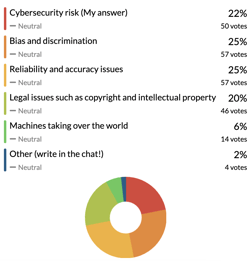In today's technological landscape, artificial intelligence (AI) has become a critical component for industries. Understanding and integrating AI is essential for keeping up with ongoing changes and advancements.
Our recent webinar co-hosted by IMD and Combient titled 'GenAI in Business' presented insights on the topic for businesses. IMD's professors and industry experts highlighted the transformative power of AI, the journey of machine learning, the role of data in driving AI as well as risks and challenges with its applications.
Lars Häggström, Sr. Advisor at IMD, opened the webinar by sharing reflections surrounding the current and future implications of AI from a conversation he had with Marcus Wallenberg the day before. Drawing on their discussion, Lars highlighted the necessity for continued learning to bridge our knowledge gaps, aiming to gradually get better at identifying the unique and specific opportunities that AI brings to organizations.
He presented insights from their dialogue, emphasizing AI's role in helping us navigate complex problems and positioning it as a potential ally in understanding complexities. However, he also relayed their joint view about the need to confront the ethical challenges this technology introduces, urging a balance that weighs the vast opportunities against managing associated risks.
Their reflections underscore the importance for businesses to leverage AI, not as an abstract concept, but as a concrete strategic tool tailored to their unique organizational needs and structures.
AI's timeline
 In the last decade, there's been a significant shift in understanding AI's capabilities. Amit Joshi, professor at IMD and one of the expert speakers, elaborated on the early days of AI, explaining, "We were trying to brute force our way into AI. We now know that that is not how the brain works. We now know that is not how intelligence actually manifests itself. We had to come up with completely new technological breakthroughs to further our progress."
In the last decade, there's been a significant shift in understanding AI's capabilities. Amit Joshi, professor at IMD and one of the expert speakers, elaborated on the early days of AI, explaining, "We were trying to brute force our way into AI. We now know that that is not how the brain works. We now know that is not how intelligence actually manifests itself. We had to come up with completely new technological breakthroughs to further our progress."
In the mid-80s, Geoffrey Hinton (also known as the 'Godfather of AI') and his colleagues introduced a new algorithm that provided the breakthrough for what we today call machine learning, a subset of AI that revolutionized the way machines were taught. The webinar also touched on the different types of machine learning, including supervised and unsupervised learning.
These techniques, well-understood and widely applied, form the basis of AI applications in many organizations today. They cater to various needs, from prediction problems in supervised learning to classification tasks in unsupervised scenarios. Understanding these techniques is essential for professionals across sectors, as machine learning's relevance continues to grow.
Within machine learning, deep learning emerged, representing a set of algorithms essential for teaching computers to learn from data examples. Amit highlighted, "The genius of machine learning was that we realized that there's an algorithm where we could train the machine by giving it examples, and if we have enough data, combined with enough computing power, machine learning could revolutionize our approach."
What goes by AI today?
The breakthroughs in AI that many organizations experience today result from a trio of elements: algorithm power, computing power, and the availability of massive amounts of data. Amit explained that what goes by AI today is nothing but a combination of these three elements. This combination explains why AI has surged forward, marking significant milestones and becoming an integral part of operational and strategic decision-making in businesses.
However, amidst this progress, there are challenges, particularly with data. Data is pivotal in the realm of AI. It's not just about having data; it's about the quality, organization, and governance of that data. "The real battle is: who has better, cleaner, more organized data that’s governed better?" Amit remarked. This "battle" is fundamental because data drives AI's learning process. To leverage AI's full potential, organizations must therefore invest in collecting, storing, and managing high-quality data in the growing quantity of data that they have access to.
-1.jpg?width=952&height=635&name=christopher-burns-Kj2SaNHG-hg-unsplash%20(1)-1.jpg)
Mishaps, bias and other risks with AI applications
The opportunities AI presents are vast, but they come with a responsibility to recognize and address inherent risks and ethical implications.
 During the webinar, Öykü Isik, IMD professor and expert speaker, addressed these risks and challenges and how the balance of opportunities with ethical responsibility is key to harnessing AI's benefits without falling into regulatory or moral pitfalls.
During the webinar, Öykü Isik, IMD professor and expert speaker, addressed these risks and challenges and how the balance of opportunities with ethical responsibility is key to harnessing AI's benefits without falling into regulatory or moral pitfalls.
Öykü dug into several examples such as the subtle yet significant impact of (unknowingly) overlooked biases in the data set preparation phase, creating noise which can influence the algorithm's behavior and outcome, and the evolving threats such as cybersecurity attacks or deepfakes of voice.
 These concerns also resonated with attendees, as revealed in a live poll, where Bias and discrimination and Reliability and accuracy issues were at the top of answers to the question, "When you think of AI risks, what comes to your mind?".
These concerns also resonated with attendees, as revealed in a live poll, where Bias and discrimination and Reliability and accuracy issues were at the top of answers to the question, "When you think of AI risks, what comes to your mind?".
The discussions served as a reminder of the less-discussed challenges in AI and the collective responsibility to mitigate these risks.
For an in-depth exploration of these topics, watch the full session, available on-demand.
As we navigate the complexities of AI in the business landscape, it is clear that the journey requires strategic learning, ethical considerations, and a hands-on approach to leveraging technology tailored to organizational needs.
Explore our AI learning initiatives, designed to support professionals on different levels and functions, and kickstart your organization's GenAI learning journey.




